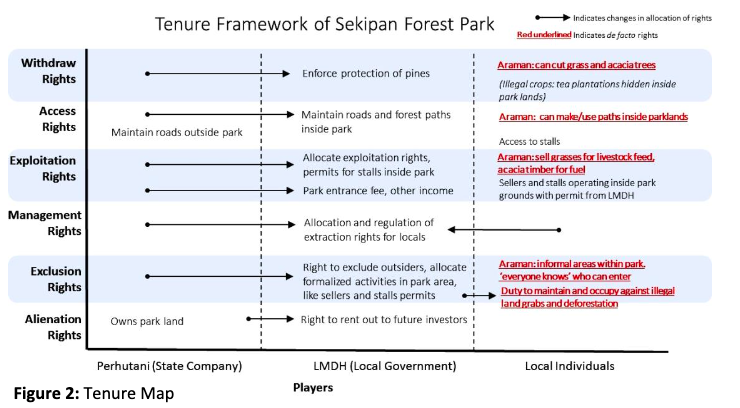

This work is licensed under a Creative Commons Attribution 4.0 International License.
To See Invisible Rights: Quantifying Araman informal tenure and its immediate relationship with Social Forestry in Central Java, Indonesia
Corresponding Author(s) : Alex Cummins
Forest and Society,
Vol. 3 No. 2 (2019): NOVEMBER
Abstract
Keywords
Download Citation
Endnote/Zotero/Mendeley (RIS)BibTeX
- Banjade, M. R., Liswanti, N., Herawati, T., Mwangi, E. (2017). Outcomes of land and forest tenure reform implementation in Indonesia. World Bank Conference on Land and Poverty, Washington DC, March 20-24, 2017.
- Barry, D., Meinzen-Dick, R. (2010). The invisible Map: Community Tenure Rights. Book: The Social Life of Forests, University of Chicago Press
- Chao, S. (2012). Forest Peoples: Numbers across the world. UK: Forest Peoples Program. http://www.forestpeoples.org/sites/fpp/files/publication/2012/05/forest-peoples-numbers-across-world-final_0.pdf
- Mahdi, Shivakoti, G., Inoue, M. (2017). Decentralization of Forest Management, Local Institutional Capacity, and Its Effect on Access of Local People to Forest Resources: The case of West Sumatra, Indonesia. In Redefining Diversity & Dynamics of Natural Resources Management in Asia, Volume 1 (pp. 305-319). doi: https://doi.org/10.1016/B978-0-12-805454-3.00016-5
- Maryudi, A., Citraningtyas, E. R., Purwanto, R. H., Sadono, R., Suryanto, P., Riyanto, S., & Siswoko, B. D. (2016). The emerging power of peasant farmers in the tenurial conflicts over the uses of state forestland in Central Java, Indonesia. Forest Policy and Economics, 67, 70-75. doi: https://doi.org/10.1016/j.forpol.2015.09.005
- MOEF. (2017). Social Forestry in Indonesia [Brochure]. Indonesia.
- Moeliono, M., Thuy, P., Waty Bong, I., Wong, G., & Brockhaus, M. (2017). Social Forestry - why and for whom? A comparison of policies in Vietnam and Indonesia. Forest and Society, 1(2), 78-97. doi: http://dx.doi.org/10.24259/fs.v1i2.2484
- Schlager, E., & Ostrom, E. (1992). Property-rights regimes and natural resources: a conceptual analysis. Land economics, 249-262. doi: http://dx.doi.org/10.2307/3146375
- Siscawati, M., Banjade, M. R., Liswanti, N., Herawati, T., Mwangi, E., Wulandari, C., Tjoa, M., & Silaya, T. (2017). Overview of forest tenure reforms in Indonesia (Vol. 223). CIFOR.
- The World Bank. (2017). Brief: Land. Retrieved from http://www.worldbank.org/en/topic/sustainabledevelopment/brief/land.
- Van Der Eng, P. (2016). After 200 years, why is Indonesia’s cadastral system still incomplete? Canberra, Australia: Australian National University.
- Van Vliet, J., Magliocca, N. R., Büchner, B., Cook, E., Benayas, J. M. R., Ellis, E. C., ... & Mertz, O. (2016). Meta-studies in land use science: Current coverage and prospects. Ambio, 45(1), 15-28. doi:https://doi.org/10.1007/s1328
References
Banjade, M. R., Liswanti, N., Herawati, T., Mwangi, E. (2017). Outcomes of land and forest tenure reform implementation in Indonesia. World Bank Conference on Land and Poverty, Washington DC, March 20-24, 2017.
Barry, D., Meinzen-Dick, R. (2010). The invisible Map: Community Tenure Rights. Book: The Social Life of Forests, University of Chicago Press
Chao, S. (2012). Forest Peoples: Numbers across the world. UK: Forest Peoples Program. http://www.forestpeoples.org/sites/fpp/files/publication/2012/05/forest-peoples-numbers-across-world-final_0.pdf
Mahdi, Shivakoti, G., Inoue, M. (2017). Decentralization of Forest Management, Local Institutional Capacity, and Its Effect on Access of Local People to Forest Resources: The case of West Sumatra, Indonesia. In Redefining Diversity & Dynamics of Natural Resources Management in Asia, Volume 1 (pp. 305-319). doi: https://doi.org/10.1016/B978-0-12-805454-3.00016-5
Maryudi, A., Citraningtyas, E. R., Purwanto, R. H., Sadono, R., Suryanto, P., Riyanto, S., & Siswoko, B. D. (2016). The emerging power of peasant farmers in the tenurial conflicts over the uses of state forestland in Central Java, Indonesia. Forest Policy and Economics, 67, 70-75. doi: https://doi.org/10.1016/j.forpol.2015.09.005
MOEF. (2017). Social Forestry in Indonesia [Brochure]. Indonesia.
Moeliono, M., Thuy, P., Waty Bong, I., Wong, G., & Brockhaus, M. (2017). Social Forestry - why and for whom? A comparison of policies in Vietnam and Indonesia. Forest and Society, 1(2), 78-97. doi: http://dx.doi.org/10.24259/fs.v1i2.2484
Schlager, E., & Ostrom, E. (1992). Property-rights regimes and natural resources: a conceptual analysis. Land economics, 249-262. doi: http://dx.doi.org/10.2307/3146375
Siscawati, M., Banjade, M. R., Liswanti, N., Herawati, T., Mwangi, E., Wulandari, C., Tjoa, M., & Silaya, T. (2017). Overview of forest tenure reforms in Indonesia (Vol. 223). CIFOR.
The World Bank. (2017). Brief: Land. Retrieved from http://www.worldbank.org/en/topic/sustainabledevelopment/brief/land.
Van Der Eng, P. (2016). After 200 years, why is Indonesia’s cadastral system still incomplete? Canberra, Australia: Australian National University.
Van Vliet, J., Magliocca, N. R., Büchner, B., Cook, E., Benayas, J. M. R., Ellis, E. C., ... & Mertz, O. (2016). Meta-studies in land use science: Current coverage and prospects. Ambio, 45(1), 15-28. doi:https://doi.org/10.1007/s1328